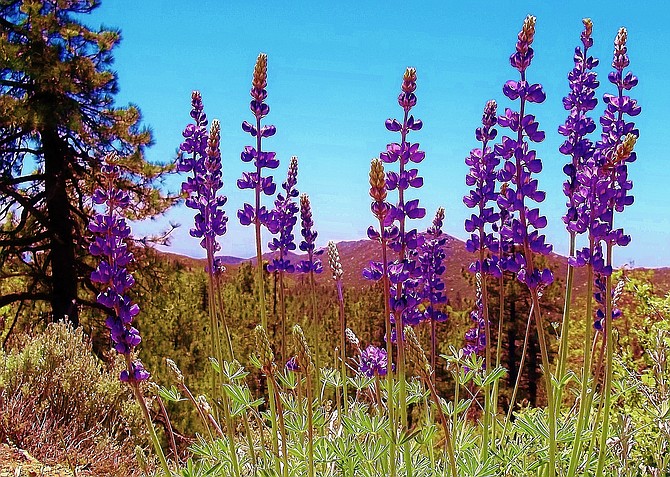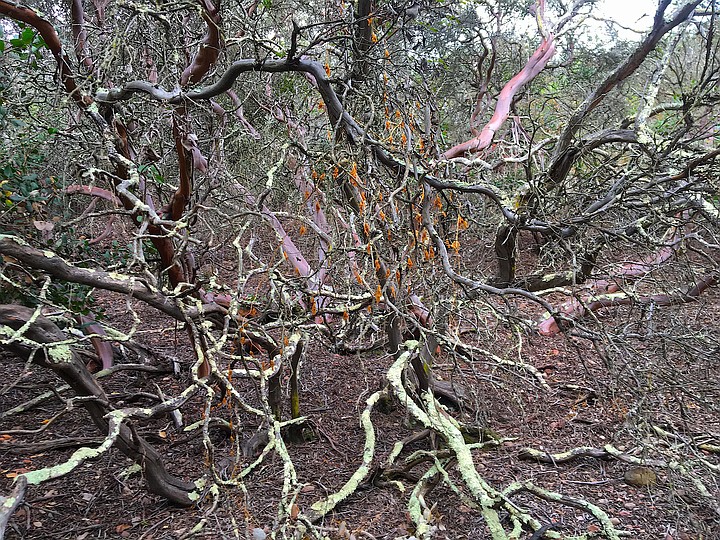 Facebook
Facebook
 X
X
 Instagram
Instagram
 TikTok
TikTok
 Youtube
Youtube

Hummingbirds, attracted to sources of nectar by red-colored flowers, are swarming over San Diego County’s back-yard gardens, scrub-covered coastal hillsides, and the warm Anza-Borrego Desert. Red monkey flower is a favorite source of nectar near the coast, while red-blossomed chuparosa and ocotillo normally play the same role in the desert. Keep an eye out for the male hummingbird’s mating “dance,” which involves soaring ascents followed by dramatic downward dives.
Lupines, whose spiky, purple (sometimes yellow) flower clusters adorn grassy areas and disturbed patches of soil, are beginning to pop up all over San Diego County. If desert rainfall cooperates, you’ll spot lupines along the sandy washes or in roadside gullies where water temporarily collects. Coastal lupines may be in full flower by late March, higher-elevation lupines will be blooming in the mountain areas in May and early June. The generic name Lupinus, meaning “wolf,” was given these plants in the belief that they robbed the soil of nutrients. Actually the reverse is true: Their ability to fix nitrogen through root nodules helps them survive on poor soils and may, in fact, enrich the soil around them.

Manzanita Shrubs are starting to bloom this month in the foothill areas of the Cleveland National Forest. The various manzanitas, characterized by smooth, reddish bark and tough, leathery leaves, bear myriad tiny, white to pinkishwhite, urn-shaped blossoms. Large (decades-old) manzanitas can be seen around Julian and in parts of the Cuyamaca Mountains that weren’t swept by 2003’s Cedar Fire. Along the coast a similar but less attractive manzanita thrives — mission manzanita.
Full Moon tonight (exact at 3:17 a.m. Saturday morning EST). The Moon is under the belly of Leo. This evening through the moonlight, Regulus is 7° to the Moon's upper right and Algieba is 7° above the Moon (again for North America.) Bring the binoculars. A typical binocular's view is about 6° wide.
The above comes from the Outdoors listings in the Reader compiled by Jerry Schad, author of Afoot & Afield in San Diego County. Schad died in 2011. Planet information from SkyandTelescope.org.


Hummingbirds, attracted to sources of nectar by red-colored flowers, are swarming over San Diego County’s back-yard gardens, scrub-covered coastal hillsides, and the warm Anza-Borrego Desert. Red monkey flower is a favorite source of nectar near the coast, while red-blossomed chuparosa and ocotillo normally play the same role in the desert. Keep an eye out for the male hummingbird’s mating “dance,” which involves soaring ascents followed by dramatic downward dives.
Lupines, whose spiky, purple (sometimes yellow) flower clusters adorn grassy areas and disturbed patches of soil, are beginning to pop up all over San Diego County. If desert rainfall cooperates, you’ll spot lupines along the sandy washes or in roadside gullies where water temporarily collects. Coastal lupines may be in full flower by late March, higher-elevation lupines will be blooming in the mountain areas in May and early June. The generic name Lupinus, meaning “wolf,” was given these plants in the belief that they robbed the soil of nutrients. Actually the reverse is true: Their ability to fix nitrogen through root nodules helps them survive on poor soils and may, in fact, enrich the soil around them.

Manzanita Shrubs are starting to bloom this month in the foothill areas of the Cleveland National Forest. The various manzanitas, characterized by smooth, reddish bark and tough, leathery leaves, bear myriad tiny, white to pinkishwhite, urn-shaped blossoms. Large (decades-old) manzanitas can be seen around Julian and in parts of the Cuyamaca Mountains that weren’t swept by 2003’s Cedar Fire. Along the coast a similar but less attractive manzanita thrives — mission manzanita.
Full Moon tonight (exact at 3:17 a.m. Saturday morning EST). The Moon is under the belly of Leo. This evening through the moonlight, Regulus is 7° to the Moon's upper right and Algieba is 7° above the Moon (again for North America.) Bring the binoculars. A typical binocular's view is about 6° wide.
The above comes from the Outdoors listings in the Reader compiled by Jerry Schad, author of Afoot & Afield in San Diego County. Schad died in 2011. Planet information from SkyandTelescope.org.
Comments